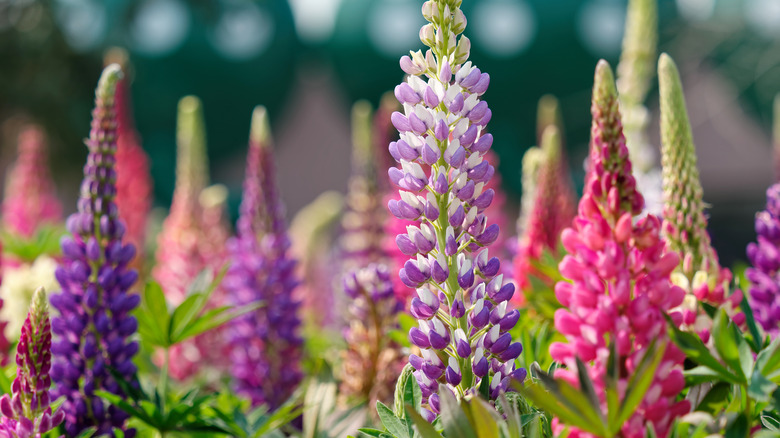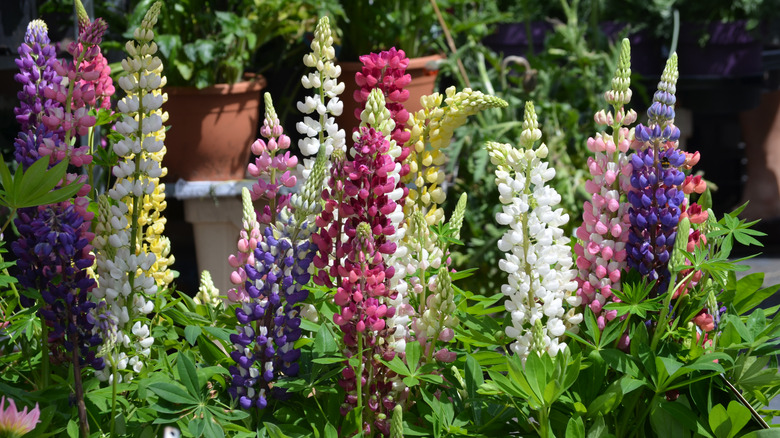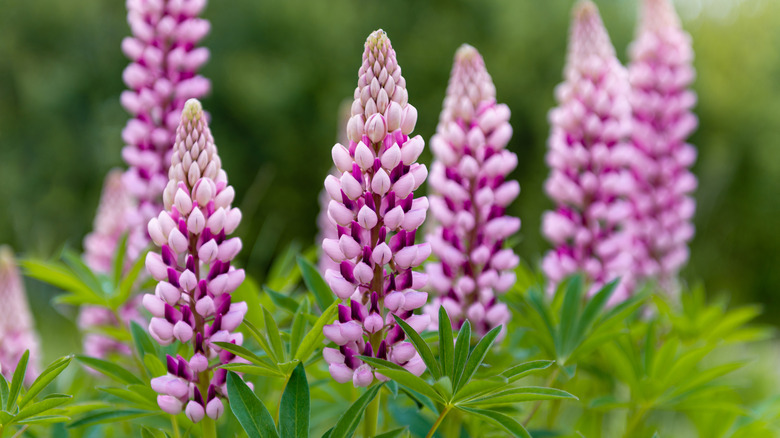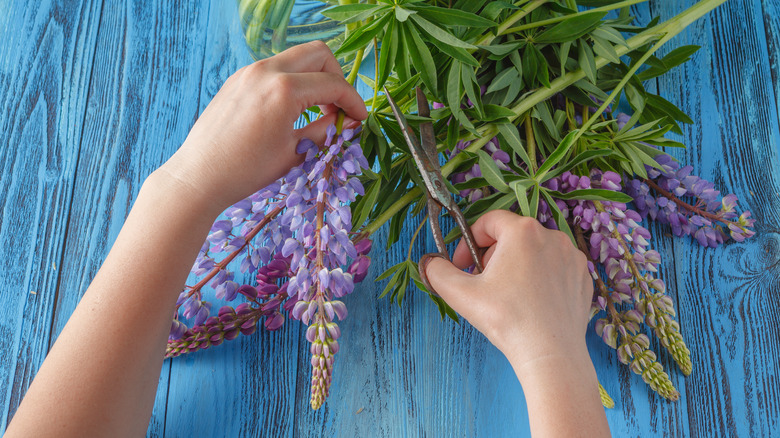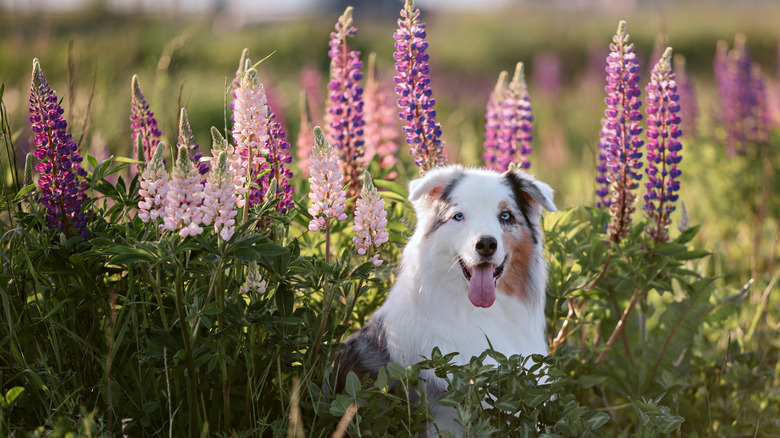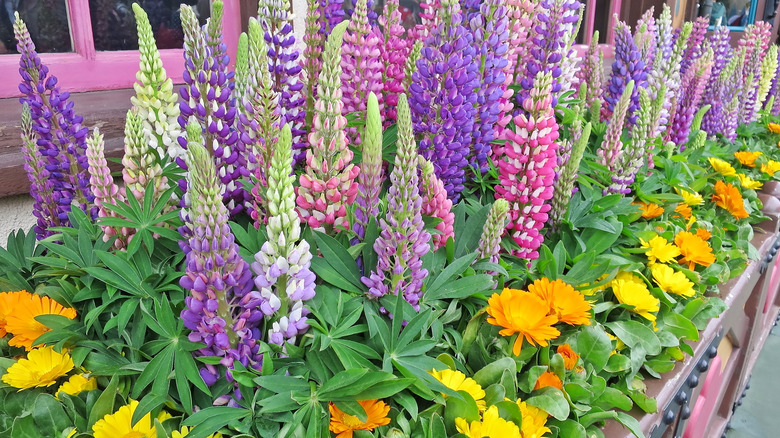How To Grow And Take Care Of A Lupine Plant
Lupine plants (Lupinus) are a wonderful addition to any wildflower or ornamental garden because of their large and dramatic flowers. These plants have tall flowers that bloom in the spring and summer and range in color from blue to orange to white. Lupine plants feature large, intricate leaves that create a perfect backdrop for the colorful, spiky flowers. With their stand-out nature, lupines are sure to make a statement in your garden.
Native to North America, lupines are available as both annuals and perennials, according to The Spruce. Most lupine plant cultivars grown in gardens are hybrids of native varieties. There are hundreds of options to choose from, all differing in color, size, and shape. Lupines are incredibly easy to care for, needing full light and infrequent watering and fertilizing. These plants can grow up to 4 feet high, and with their towering flowers, they will stand out amongst shorter garden plants and flowers.
How to use lupine in your garden
Not only are lupines a beautiful addition to your ornamental garden, but they are also beneficial to your other garden plants. Lupine plants are actually a type of legume, although they are not edible. They are able to draw nitrogen into the soil and enrich it through their roots, explains American Meadows. Because lupines can help increase nitrogen in the soil, they make great companion plants for your garden. As a bonus, lupines are resistant to deer and other garden pests, and they attract pollinators such as bees and butterflies to benefit surrounding plants as well.
The whimsical and colorful character of lupine blooms and their low-maintenance nature makes them a great addition to your wildflower or cottage garden. They can grow to carpet an entire meadow, and coexist well with other field wildflowers such as poppies. Lupines also look beautiful when paired with other perennials such as tulips and daffodils. In cottage gardens, they look particularly stunning with allium plants, phlox, or globe thistle.
How to grow lupine
Planet Natural discusses the few easy steps to grow lupine plants in your garden. There are three ways to grow lupine: from seeds, cuttings, or divisions. Lupines prefer to be planted in full sun with average to sandy soil. Before planting, loosen the soil about a foot down so that the long, delicate roots have room to establish themselves. Because the roots are so fragile, transplanting lupines is not recommended, as any damage can be detrimental to the plant.
Lupine seeds have a tough outer shell, so they should be softened before planting. To soften the seeds, cover them with a damp paper towel and place them in a Ziploc bag in the refrigerator for a week, or let them soak in warm water for several hours. These seeds can then be sown outside in the spring or summer; however, untreated seeds do better when planted in the fall. Plant the seeds a 1/4 inch deep in loose topsoil and space them 2 to 3 feet apart. You should see growth 15 to 25 days after sowing, and they should produce blooms within a year of planting.
You can also grow lupines from cuttings or divisions, which requires cutting the original plant down to the trunk and placing the cut stem in propagation medium or gritty sand. Once the plants begin to grow roots, their pots can be moved outdoors. Remember, however, to avoid transplanting lupine propagations into new pots, as their roots may not survive.
How to care for lupine
Once lupine plants are established, they are relatively low-maintenance, making them perfect for a wildflower or cottage-style garden. They require moist soil after planting to help their roots develop, so make sure to water them regularly during this period. However, after they are developed, they only need to be watered if they encounter drought conditions, per Garden Design. Otherwise, rainfall will do the trick. Lupines do well in dry conditions and actually prefer that to being oversaturated with water. Lupine plants also don't require fertilization because they are able to absorb nitrogen from the air for themselves, in addition to enriching the surrounding soil.
The primary maintenance that lupines require is deadheading when their blooms are fading in the fall. By deadheading the spent flowers, you will encourage new blooms. At the end of the season when the foliage begins to fade and turn yellow, cut the plant to the ground. This method of pruning will help encourage new growth the following year.
Lupine varieties
Because lupine plants are bred as hybrids, there are hundreds of species available in all different colors and sizes. You can usually see lupines in blue, white, and yellow, but other colors exist as well. Some varieties of lupine plants can grow up to 4 feet tall, while shorter varieties also exist. Almanac describes a few common varieties of lupine plants.
-
Texas Bluebonnet (Lupinus texensis): These striking dark blue flowers with contrasting white spots draw crowds to Texas fields when they bloom in April.
-
Wild Lupine (L. perennis): Native to eastern North America, these blue flowers look beautiful in any garden.
-
Russell Hybrid Lupines (L. polyphyllus): This variety of garden lupines is used to create new hybrids. You will find this variety in shades of red, yellow, pink, purple, and white.
-
Dwarf Hybrid Lupines: Growing to only 18 to 24 inches tall, these varieties of lupines are much smaller compared to traditional lupine varieties that can reach up to 4 feet tall.
-
Lupine Woodfield Hybrids: These lupine hybrids feature dark colored flowers ranging from deep purple to white in color.
Is lupine toxic?
Lupines are a beautiful addition to your garden, but they are dangerous if ingested by humans and animals alike. If children consume lupine plants, they may experience dizziness and loss of coordination, according to Wag Walking. Younger plants are more toxic than mature ones, and the seeds are particularly dangerous for human ingestion. Therefore, lupines should be planted in areas where young children won't have access.
Not only are lupines dangerous for human ingestion, but they are also dangerous for cats, dogs, sheep, cattle, goats, and horses. For dogs specifically, smaller amounts won't cause much damage. Still, in large quantities, ingestion of any part of the lupine plant can cause lethargy, loss of appetite, liver issues, difficulty breathing, or respiratory paralysis, and can be fatal if not treated immediately. If you suspect that your pet has ingested part of a lupine plant, seek veterinary care immediately. Take care when planting lupines to place them in an area that pets don't have access to so you can best ensure their safety.
How to repot lupine
As previously mentioned, lupines have elaborate root systems, meaning they do not transplant well once they are established. Repotting your lupine plants isn't a good idea unless you are extremely careful with moving them, because any disturbance to the roots can cause damage to the plant. That being said, lupines can be transplanted as seedlings, with precautions, and these flowers do well growing in large pots. If repotting your lupine plants is absolutely necessary, SFGate explains the best way to do so to ensure the longevity of your plants.
If repotting seedlings, put the seedlings in their original pots outside to allow them to harden-off, or adjust to outdoor climate conditions for about a week. Next, prepare your new pot with well-draining soil and dig a hole slightly deeper and twice as wide as the seedling pot or root ball. If repotting an already established lupine plant, carefully dig the plant out of the ground, taking care to avoid disturbing the root ball. If planting a seedling, carefully remove it from the original pot. Holding the stem or leaves, place the root ball in the newly-dug hole, refill it with soil, and water the plant. Lupines will grow happily in pots, and that allows you some freedom to move the plant around your garden throughout the changing seasons, which you wouldn't be able to do if it was planted in the ground.
